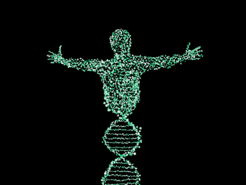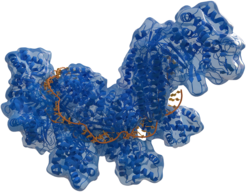CRISPRs! Elegant tools that create a beautiful mess
by Srinath Ramkumar

A cloudy day in Autumn it was, when we heard the news about a scientist in China having used CRISPR/Cas9 to alter a gene of twin baby girls with the pseudonyms Lulu and Nana for the first time. This news left the scientific society in shock. Many questions came to mind as one pondered the implications of this incident, not only scientific questions, but (maybe more importantly) ethical questions, which needed to be addressed immediately. CRISPR/Cas9 technology provides us with the means to edit genes with high specificity. Thus, it enables us to add or remove particular traits and characteristics to living beings. What was once merely science fiction, has now become reality.
To better fathom out the consequences of what happened, we need to understand the biology behind the technology first. DNA is the core genetic material in all living organisms and it consists of two complementary strands forming a double helix. Usually, the cellular repair machinery takes care of damages to the DNA. Damages such as breaks in individual DNA strands can be repaired easily. When one of the two strands break, the repair machinery uses the second strand as a template to rectify the break. Breaks in both DNA strands are more difficult to repair. However, the Cas9 enzyme, which was originally identified in bacteria, can induce double strand breaks. It uses a template RNA to target and bind to genomic DNA. There it introduces a break in both strands of the DNA. This scissor-like feature can be very useful: scientists use it to target regions of the genomic DNA of other organisms. Cas9 can be introduced into cells of another organism to achieve targeted mutations. Scientists introduce Cas9 in a cell to induce a double break at a particular targeted location in the DNA. The cellular repair machinery finds it difficult to perfectly fix this double strand break introduced by the Cas9 and hence ends up resulting in erroneous corrections. This particular erroneous repair process gives rise to what is called a mutation in a gene.

A mutation could cause various effects on the gene itself, such as a loss of function. When a mutation is carried by all cells in the body, including those that produce the ovum and the sperm, it is a heritable mutation, also called a germline mutation or a heritable mutation. Scientists working with biological model organisms such as mouse or zebrafish use Cas9 commonly to achieve this germline mutation. They edit the DNA of the fertilized ovum from the parents before it develops into an embryo. Through the course of development, all the cells of the organism are derived from this ovum. Hence, when the gene of the ovum is mutated, cells of the embryo carry this mutation. Once the embryo reaches adulthood, it can impart this mutation to its offspring through its own germ cells. Therefore, such a mutation can progress in a hereditary manner, hence called a heritable mutation. Since this mutation exists in the cells which are part of the reproductive system (called germ cells), it is also called a germline mutation.
Thus, scientists have been utilising CRISPR/Cas9 as a potent tool to induce such mutations since it was first demonstrated only seven years ago. It has been one of the quickest genome-editing tools to be adopted into the handbook of genetic techniques. The primary reason is its ease of use, speed and efficiency compared to any other conventional techniques. Gene editing techniques existed prior to CRISPRs in many forms, for example Transcription Activator-Like Effector Nucleases (TALENs) and Zinc Finger Nucleases (ZFNs). But true to how a technology progresses, CRISPR/Cas9 proved to be faster, more accurate and efficient. Like with most other genome-editing techniques, we still need some time to understand the potential risks and off-target effects of CRISPR/Cas9 before adopting it to human genome editing.
The introduction of the CRISPR/Cas9 technique has given rise to many discussions amongst scientists on editing the human genome in a heritable manner. The American National Academies of Sciences, Engineering and Medicine (NASEM) conducted a thorough study and published a very detailed report on the Science, Ethics and Governance of Human Genome Editing. In this report, the committee left the terminologies vague particularly on how such experiments should be regulated. Although they did not call for an international ban on the usage of these tools, they called for individual governments to regulate such experiments according to what each country deemed appropriate and necessary based on the diversity of its demographics.
Going back to the aforementioned controversial experiment, the Chinese scientist mutated a gene that is responsible for interacting with the Human Immunodeficiency Virus (HIV). This interaction of the gene and HIV leads to a compromised immune system in a person carrying the infection. Scientists have shown that in patients with HIV induced immunodeficiency, if this interaction is lost, then the immune system is able to function almost normally, hence leaving a patient immune to HIV. Hence, the Chinese scientist attempted to inhibit this interaction by mutating this particular gene in the embryos, de facto making the babies immune to HIV. This seems to be a logical use of the technology for the benefit of mankind. However, the consequences of using the CRISPR/Cas9 technique are not yet fully understood. One of the biggest challenges with nascent technologies, such as CRISPR/Cas9, is the unpredictable side-effects. One of the major reasons for basic research in biology consuming very long time is due to its complexity of the mechanisms. There are multiple possibilities of inducing side-effects beyond what one could have predicted. Hence, scientists try to develop more targeted tools to understand basic biological mechanisms.
The Chinese Academy of Sciences and the Chinese government were in agreement with these regulations from the NASEM report, yet the research was somehow allowed to proceed. Questions arise as to how the scientist was able to get around these regulations. The Chinese authorities led an investigation into the ethics and procedure of the conducted experiment, and declared that the scientist had “forged documents” to dodge supervision. It was even revealed that he had a circle of close to sixty scientists and advisors around him who were aware of the experiment before the news of his experiment got out. This group has infamously been named the Circle of Trust behind the world’s first gene edited babies, since they neither reported what he was doing, nor did they attempt to put an end to this work.
Chinese institutes utilizing the CRISPR/Cas9 system believe that their work is being undermined by the international community, since a scientists’ reputation is generally also associated to the scientific credibility of the country in which they work. An additional concern for other researchers working in China with CRISPR/Cas9, is that this scandal has subjected their work to exaggerated scrutiny. For scientists working on human cells which are not inheritable between generations (viz. somatic cells), regulations have become stricter and funding has become more difficult to acquire. Although many researchers in Chinese universities have adhered to the western standards, many scientists believe this scandalous experiment has left an indelible mark on their reputations and credibility. It still remains unclear what the future holds for the scientists whom this has impacted.
Throughout human history, people have sought to improve themselves, invent new technologies, and most of all, uncover the mysteries of nature and evolution. In the past, scientists have developed a wide variety of technologies, which enable us to understand the microscopic world of biology. Today, with great tools such as CRISPR/Cas9, scientists are able to program in the most advanced coding language that exists in the world, the genetic code, thereby making them the hackers of the future. The question is to what extent are we going to permit this reprogramming, and how. One could argue that systematic and thorough research is necessary for progress in any field. Therefore, the regulatory bodies and funding agencies should systematically fund and encourage research in basic sciences with the use of the CRISPR/Cas9 tools. One could also argue that there is always a high probability of rogue experimentalists, who might embark on careless adventures, such as the Chinese example. One way to stop and regulate such experiments is to legalize and regulate heritable genome editing in a controlled manner. Strict regulations must be imposed globally and governments must adhere to these standards, although, they may be given the flexibility to enhance the stringency of these rules. On the other hand, ethical guidelines are harder to impose. The definition of what is considered ethical also changes with the increasing utility of a technology. For example, the ethics and acceptance of in-vitro fertilization has changed a lot in the past forty years. Therefore, it is only a matter of time until the ethical issues raised by heritable genome editing are solved. As humans, we need to be prepared for what our future has in store for our species and how we are able to adapt to it. Nature has played its hand and the ball is in our court now. It’s up to us to pave our path forward.
P.S. If you noticed carefully, all the paragraphs of this article begin with the letters of the genetic code (A,T,G,C).
References
https://www.sciencemag.org/news/2019/08/untold-story-circle-trust-behind-world-s-first-gene-edited-babies
http://ewanbirney.com/2018/11/crispr-babies-consideration-science-ethics.html
https://www.nap.edu/catalog/24623/human-genome-editing-science-ethics-and-governance
https://thenode.biologists.com/crispr-cas9-whats-left-to-know/research/
https://onlinelibrary.wiley.com/doi/abs/10.2307/3560906?sid=nlm%3Apubmed
https://www.nature.com/articles/d41586-019-00726-5
https://www.wired.com/2010/04/ff-hackers/
https://en.wikipedia.org/wiki/Transcription_activator-like_effector_nuclease
https://en.wikipedia.org/wiki/Zinc_finger_nuclease
https://www.ncbi.nlm.nih.gov/pmc/articles/PMC4343198/
https://en.wikipedia.org/wiki/CRISPR
Title Courtesy: Zacharias Kontarakis - ex-MPIHLR, Stainier Lab













